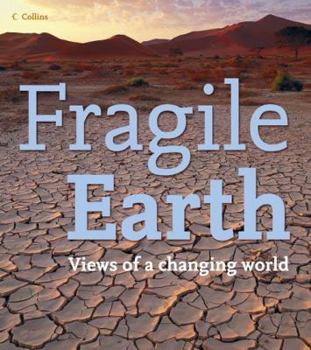Fragile Earth: Views of a Changing World
No Synopsis Available.
Format:Hardcover
Language:English
ISBN:0007233140
ISBN13:9780007233144
Release Date:January 2006
Publisher:Collins
Weight:3.66 lbs.
Dimensions:11.3" x 0.9" x 10.1"
Customer Reviews
4 ratings
ASTONISHING PHOTOS
Published by Thriftbooks.com User , 17 years ago
It was a surprise to see the photos inside, is very good planned the chapters, and really is look of our earth, from Asia to America. If you want ilustrated the climate change, you have to buy this book.
Images of an unstable world
Published by Thriftbooks.com User , 17 years ago
Most of us go through life with the assumption and perspective that the world around us is stable. The occassional tsunami or hurricane impresses us on the evening news but the world overall is mostly unchanging. This book will change that perspective and assumption. Changes in climate, population, pollution, the wreckage of wars and other man made causes as well as natural events such as earthquakes, volcanism, floods, and weather on the earths surface are shown with before and after images. The most interesting to me were the changes in Greenland's ice sheets and many of the world's glaciers due to climate changes and the stark deforestation of the tropics due to burning and agricultural development. I found the section at the end of the book titled "Future Views" to be an interesting collection of concise essays on the graphical presentions in the preceding section of the book. You make take these as factual or opinion piece but they like the book are stimulating and will make for good conversation around the coffee table.
Glimpses of the neighbourhood
Published by Thriftbooks.com User , 17 years ago
Anybody left harbouring doubts about the reality of climate change will be relieved of them by this book. The images of how glaciers are disappearing, the sea rising to threaten coastal communities or the ravages of intense storms are a jarring sight. The Collins team has performed an outstanding service in compiling such a span of places and conditions in demonstrating what is happening and is likely to occur in our future. With added commentary from a selected group of those interested in environment issues, this is a valuable visual package. The book is comprised of eight chapters of categorised imagery and one of comment on future conditions. Opening with such natural phenomena as earthquakes, tsunamis and cyclones and tornadoes, the images of human activity follow. Although the natural forces are the stuff of The Weather Channel, there are some human-created conditions that will be novel to many. Dutch land reclamation from the sea was depicted in our childhood reading, but the images of a set of man-made islands off the coast of Dubai may be something of a jolt. Looking like some flower or a bizarre insect, they are known as the "Palm Islands" for their resemblance to that plant. Water, in one of its many forms, takes up a significant portion of the book. Glaciers may seem remote and of little value except for tourism, but some cities, such as Lima, Peru, rely on glaciers as a water source. The loss of glaciers means far more than the loss of a city's supply. As the Polar, Greenland and Canadian snow and ice melt away in rising temperatures, lowland civilisations are threatened with inundation. It may be easy to overlook the drowning of a Pacific Island nation like Tuvalu, but the millions of people displaced by flooding in Bangladesh will be a challenge its neighbours will have to cope with. The map depicting this flooding is hard to interpret in human terms - the scale is too small. Nevertheless, there are people in that zone of beige marked on the map. The comments concluding the book are of interest, but reading them is a chore. In its effort to give modernity to the book, the page and print colours are far too close for proper readability. However, the reading is worth the effort for such articles as those by Mark Lynas and Tim Flannery. The editors, struggling to deliver a "balanced" presentation, slipped Bjorn Landstrom, the "Sceptical Environmentalist", in as a naysayer. Claiming to have observed the images, he then puts forward the notion that "technology" will save the species. Where Lima will obtain its water or how the Bangladeshi will be replanted elsewhere without social impact, seems to have escaped his notice. The editors might have found a more rational sceptic to include, but those are becoming as rare as the Golden Toad. Nevertheless, it is the images and explanations of their import that render the book an indispensible tool. [stephen a. haines - Ottawa, Canada]
Pictures are worth a thousand words.
Published by Thriftbooks.com User , 18 years ago
This is a book for those interested in the environment, business, photography or science. I teach business courses to adults. This book demonstrates the awesome power of paired photos to convey important messages about dramatic changes over a very short period of time. This book is worth your investment of time and money. I am grateful to the publisher for this great work. [email protected]





